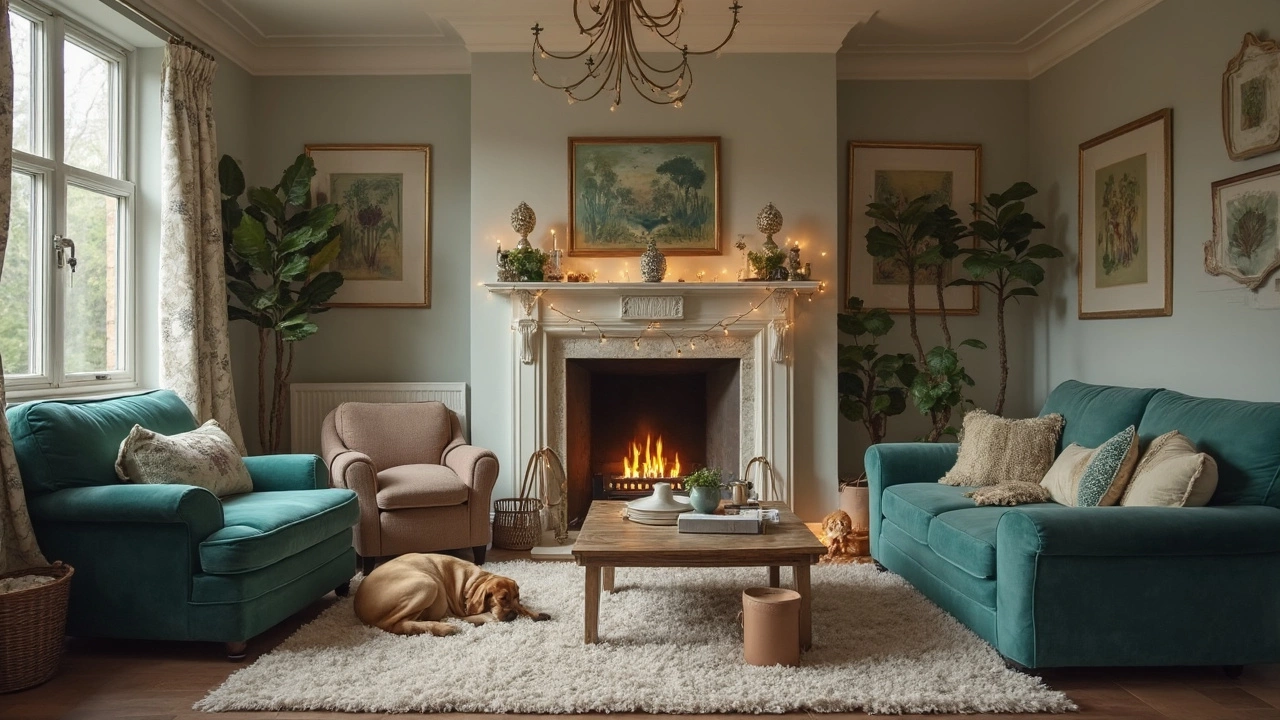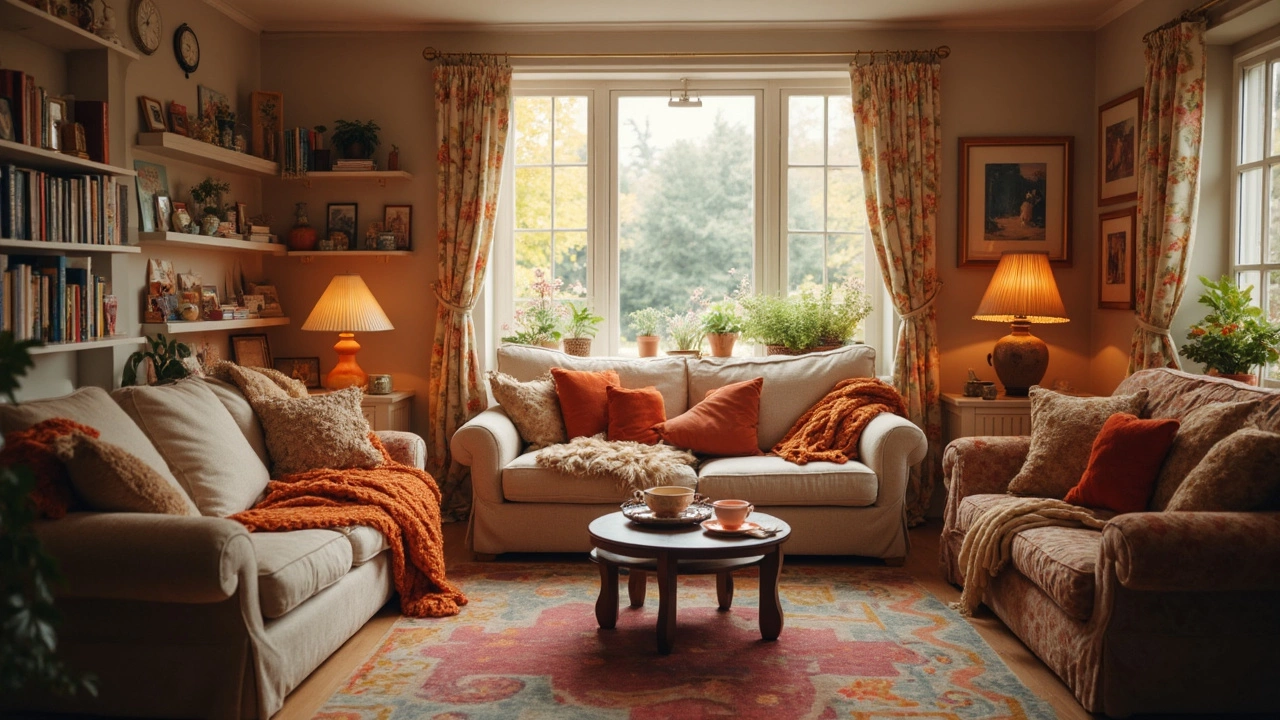The first thing anyone notices when stepping into a living room? How it feels. You don't need to spend loads of money or have a designer on speed-dial to make your space cozy. Start by thinking about what actually makes a place welcoming—soft lighting, comfy seating, the little things that make you want to kick off your shoes and stay awhile.
Grab a couple of throw blankets and toss them on your sofa. One quick fix I swear by: folding a knit blanket over the back of the couch, right where Clementine curls up to read, instantly makes the room feel snug. Even older furniture looks warmer dressed up this way. Pillows are magic too—especially the squishy, mismatched ones from the kids’ rooms (somehow, Silas’s dinosaur print has become the family’s favorite).
Lighting changes everything. Skip the harsh overhead lights and go for table lamps or even fairy lights. Warm bulbs (think soft white or golden) make a room feel calm and inviting, while cool white screams ‘dentist office.’ Layer different light sources: one lamp by the reading chair, another on the side table, maybe some candles for movie nights. Suddenly, your living room glows instead of glares.
- Start with Soft Lighting
- Layer Up With Textiles
- Pick Warm and Inviting Colors
- Personal Touches That Tell Your Story
- Declutter for Peace of Mind
- Arrange Furniture for Connection
Start with Soft Lighting
If your goal is to make your cozy living room actually feel cozy, forget about those bright, ceiling-hogging lights. Soft lighting sets the mood and brings actual warmth to your space. Ever notice how a café feels way more inviting when they use lamps instead of a spotlight? The same trick works at home.
Start by picking warm white LED bulbs. Check the box for a color temperature between 2700K and 3000K—anything higher feels too crisp and sterile. Place table lamps at different levels around the living room. Got a little shelf space or a spot next to your favorite chair? Stick a lamp there. This spreads light gently, instead of blasting it from above.
For instant results, swap out any out-of-place bulbs for warm ones. Add a few battery-operated candles (they look real and never burn tiny fingers). Fairy lights don’t just belong in kids’ rooms—wrap them around a bookshelf or tuck them into a glass vase for a soft glow in the evenings.
- If your space lacks plug sockets, try rechargeable bulbs or small lamps that work anywhere. No wires, no hassle.
- If you have dimmer switches, use them! Adjust lighting based on your mood or what you’re doing— it’s a game changer for evening relaxing.
- Include a reading or floor lamp in your favorite corner. It’s perfect for solo time, or if someone wants to read while the rest of the room glows softly.
Here’s a quick breakdown on lighting types and where to add them for maximum comfort:
| Type of Light | Best Spot | Effect |
|---|---|---|
| Table Lamp | Side Table, Bookshelf | Local, cozy |
| Floor Lamp | Reading Nook | Focused, warm |
| Fairy Lights | Shelving, Vases | Decorative, gentle |
| LED Candle | Coffee Table, Mantle | Soft, safe flicker |
Good lighting sets the stage for everything else. The right mix of sources makes your living room the place everyone wants to chill.
Layer Up With Textiles
Blankets and pillows are the secret sauce for a truly cozy living room. Textiles add softness, bring color, and actually keep you warm—so they're not just for looks! The texture and layering matter a lot. Think big knit throws, velvet cushions, chunky weaves, and those fuzzy sherpa or faux fur pillows you can’t stop hugging.
You don’t have to buy all new stuff. Grab what you have in the closets. Mix and match. A stack of lighter quilts in a basket looks inviting and gives anyone permission to get comfy. Let the kids pick out a “family blanket” for the back of the couch—trust me, they’ll actually want to sit with you more often.
- Throw blankets—aim for at least two, different textures, and easy-to-wash.
- Accent pillows—mix patterns and fabrics, and don’t stress about them “matching.”
- Area rugs—even if you have carpet, layering a small rug adds warmth and zones the space.
- Window curtains—swap out sheer ones for heavier, lined panels when it’s chilly.
Fun fact: Adding just one plush area rug can boost the room’s insulation, making it feel four degrees warmer on your feet, especially on hardwood or tiles. If you live somewhere drafty, thick curtains help keep heat in and cold out.
| Textile | Average Cost (USD) | Cozy Factor |
|---|---|---|
| Faux Fur Throw | $25–$60 | High |
| Knit Blanket | $15–$40 | Moderate |
| Chunky Area Rug | $50–$200 | Very High |
| Velvet Pillows | $10–$30 | High |
Layered textiles soften sound, too, so your living room feels less echoey and more like a hug. If shoes are off in your house, make rugs and throws a must. Little changes add up—and before you know it, “let’s go hang in the living room” becomes everyone’s new favorite suggestion.
Pick Warm and Inviting Colors
If you want your living room to feel cozy, the colors you use are a game changer. The right shades can instantly make a space feel softer and more inviting. You don’t have to paint all the walls, either—sometimes, just swapping out pillow covers or adding a colorful rug is enough.
Warm colors, like soft beige, creamy off-white, rich terracotta, or even muted greens and blues, make a room feel calm and homey. Steer clear of icy greys and sterile whites—they tend to feel cold and not so family-friendly. Interior designers usually recommend going for earth tones since they work with almost any furniture and don’t go out of style. You can even mix in some deeper shades like charcoal or navy for a little contrast if that’s your thing.
Here’s what works for a cozy living room look:
- Wall paint in creamy whites, tan, or light taupe for a base that feels gentle.
- Accent items (pillows, throws, art) in burnt orange, olive green, mustard, or even dusty rose for a pop of warmth.
- Wood furniture or frames—they add natural warmth, especially if your color scheme is pretty neutral.
- Layer different finishes. Try a chunky knit pillow against a smooth leather chair or a fluffy rug to keep things interesting.
According to a recent survey by the National Association of Home Builders, over 70% of homeowners picked warmer tones or earth colors when renovating their living rooms in 2024. That’s probably because everyone wants their main hangout spot to feel relaxed and welcoming—not like a show room.
When you’re shopping or picking out paint samples, bring them into your space and check them out in natural light. Colors can look totally different depending on where you use them. If you’re hesitant to commit, start small: grab new pillow covers or a soft, colored throw. These small changes can create that sense of comfort without much effort or money spent.

Personal Touches That Tell Your Story
If you want your cozy living room to feel like YOUR place, add stuff that actually means something to you and your family. Forget the generic art from the store. Even a wall full of your kids’ wildest school art or travel photos makes the room a hundred times more inviting. It doesn’t have to be magazine-perfect—it just has to mean something.
Family photos in mismatched frames? Totally fine. That handmade pottery bowl Silas brought home? If it holds keys or snacks, even better. Little items bring back memories every time you walk by. According to design expert Emily Henderson, “The best rooms tell stories about the people who live there. Don’t hide your personality—show it off.”
- Swap out the generic tray on your coffee table for something you found on vacation, or at a local market.
- Hang up art you (or your kids) actually like—not what you feel you ‘should’ have.
- Use favorite books as décor—stacked on a shelf, or under that lamp in the corner.
- Display collections, even if it’s just little figurines or vintage postcards you love.
And here’s something interesting—a Houzz survey found that over 40% of homeowners feel more relaxed at home after displaying personal and sentimental items. So all those quirky souvenirs and “ugly-cute” crafts? Turns out, they’re not clutter—they’re comfort. Personal touches are what turn a basic space into a spot where your family actually wants to hang out, put their feet up, and make more memories.
Declutter for Peace of Mind
There’s nothing cozy about piles of paperwork, random toys underfoot, or stacks of mail that never seem to disappear. Decluttering doesn’t have to mean going full-on minimalist, but it does mean making space for actual living (and for feet—trust me, I’ve stepped on enough blocks to know the pain). Research from UCLA’s Center on Everyday Lives and Families actually links cluttered spaces to increased stress levels, especially for women. Less mess equals less stress.
Start small. Take ten minutes a day to tackle one surface—maybe the coffee table or that mysterious basket where remotes and hair ties go to hide. Regular mini-sessions work better than a giant overhaul you’ll put off forever. If you haven’t used something in your living room in the last six months, chances are it can leave. Be honest: is that magazine pile for reading or just collecting dust?
- Get baskets or boxes for kid stuff (Silas’s LEGOs and Clementine’s art supplies each have a home in ours).
- Have a "drop zone" for mail and keys, so things stop spreading across every flat surface.
- Keep a tray on your coffee table for remotes and coasters. If it doesn’t fit, it probably doesn’t need to live there.
| Clutter Source | Solution |
|---|---|
| Toys | Dedicated baskets |
| Papers/mail | Wall organizer or shred |
| Blankets | Storage ottoman |
| Remotes/electronics | Tray or small container |
Once you have less stuff lying around, your cozy living room vibe actually stands out. You notice the soft rug, the calm lighting, the space to breathe. That’s when the room starts working for you, not against you.
Arrange Furniture for Connection
If you want your cozy living room to actually feel, well, cozy, how you set up your furniture makes a huge difference. Where you put the sofa, chairs, and tables can turn a room from cold and awkward into one where the whole family naturally hangs out together. People have even studied this—living rooms that encourage face-to-face conversations actually get used more!
Start by thinking about the real center of your room. Maybe it’s the fireplace, TV, or just your favorite window. Anchor your furniture around that—not the walls. Here’s a simple trick: pull the couch and chairs a bit closer together, so you’re not shouting across the room during a movie night. If you have space, make a U-shape or L-shape with your seating for better eye contact. Even in a small living room, angling a chair or tossing a cushy ottoman in can add comfort without taking over the space.
- Group seating in clusters—pairs or trios work best, not everything lined up on the walls.
- Keep end tables or coffee tables within reach; this is for convenience and it makes people stay longer.
- Leave enough space for walking paths, so no one trips over toys (Silas’s Hot Wheels, anyone?).
- Try moving your largest piece—as little as 10 inches off the wall can change up how ‘open’ your room feels.
If your family loves board games or crafts, add a low table with stools or floor cushions. Experts from IKEA suggest multi-use furniture because it lets you easily swap setups for family nights, solo reading, or even having a friend over for coffee.
Want proof that better furniture layouts make a difference? According to a 2023 Home Comfort Study, families who created “conversation zones” in their living rooms reported spending about 2 hours more per week together in the same space compared to homes where the furniture was spread apart or facing just the TV.
 EN
EN
 HR
HR
 AR
AR

